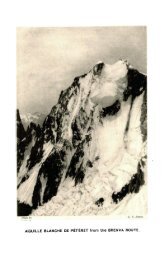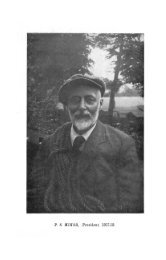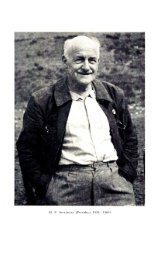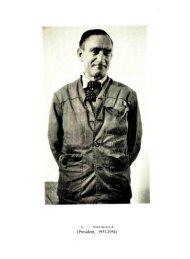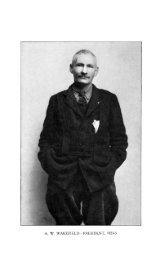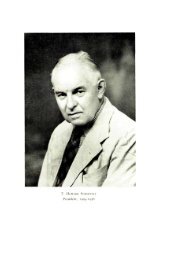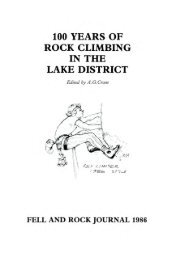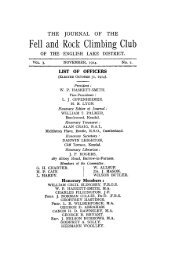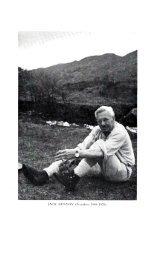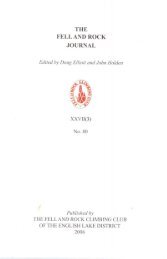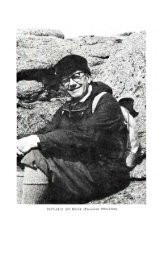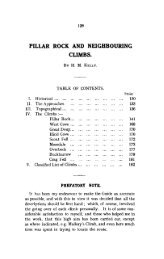Year of publication 1990 - Fell and Rock Climbing Club
Year of publication 1990 - Fell and Rock Climbing Club
Year of publication 1990 - Fell and Rock Climbing Club
Create successful ePaper yourself
Turn your PDF publications into a flip-book with our unique Google optimized e-Paper software.
Peter Fleming 53to the north-west <strong>of</strong> Simon's Nick. Indeed, the vein can be traced on thesurface where it has been "tried" along its length. We rigged an abseilrope down the shaft. Ten metres lower it was necessary to put in adeviation belay to avoid loose, jammed blocks. After a further 10metres, the bottom was reached. We were on familiar ground. It was nosurprise to find ourselves on Top Level in Tunnel T3 next to the BoxingDay dig. We had decided some years previously that this overhead stopewas blind. This assumption had just been proved to be incorrect.Whilst this descent was in progress the rest <strong>of</strong> the team had retrievedthe maypole from nearby Woodends Shaft, where it had been for almosttwo years, <strong>and</strong> re-erected it alongside the ladder mentioned earlier. Thisenabled them to reach a short tunnel with a rise at the end. terminatingin a small overhead stope. An ore pass dropped down to the lowertunnel <strong>and</strong> then entered an ore shute down to Top Level.Whilst the group were recovering the maypole from Woodends Rise,one <strong>of</strong> them noticed what appeared to be the apex <strong>of</strong> a tunnel ro<strong>of</strong>buried in the debris at the base <strong>of</strong> the shaft. This was excavated on the15th January 1989. The material removed was a light-coloured, fineslurry, with no solids in it. This must have been tipped down the shaft.but why <strong>and</strong> from where it originated is a mystery. A tunnel wasrevealed which was approximately IS metres long, running in a northwesterlydirection to a blind end.With the biennial conference <strong>of</strong> N.A.M.H.O. due to be held in July1989. one <strong>of</strong> the proposed field trips involved a guided tour <strong>of</strong> LeversWater Mine, abseiling down Brow Stope. followed by a tour <strong>of</strong> TopLevel Extension via the new connection, then out to surface via AreteChamber <strong>and</strong> the "Crater". Some preparatory work had already beencarried out for this excursion, but in order to reduce the high water levelin Levers Water Mine, a large quantity <strong>of</strong> rubble needed to beremoved from the entry area to lay a drain. All this material would haveto be tipped down the "Funnel" (see Cross Section No.2). with thepossible result <strong>of</strong> sealing <strong>of</strong>f hitherto unexplored areas below. With thisin mind it was decided to have a look down there before workcommenced, so on 16th April 1989, five members <strong>of</strong> Cumbria AmenityTrust started out on this project. They did not expect to get very far. Itmust be borne in mind that the "Funnel" has been eroding away <strong>and</strong>getting larger over a very long period. Many hundreds <strong>of</strong> tons <strong>of</strong> clay<strong>and</strong> rock have gone down below already.From the bottom <strong>of</strong> the first pitch, which was familiar ground to us,we prepared to abseil down to the north-west. Great care had to betakenbecause <strong>of</strong> the loose, unstable nature <strong>of</strong> the stope. jammed withpoised jagged rocks. Any horizontal progress was barred by collapses



